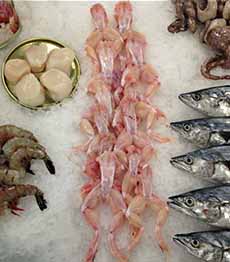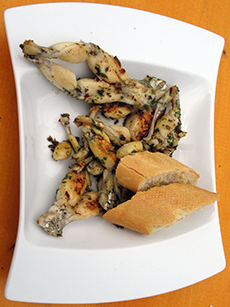LEAP YEAR FOOD HOLIDAY: National Frog’s Legs Day
|
February 29th occurs only once every four years: It’s the leap year day. There are actually two food holidays on Leap Day: Frog’s legs are one of the better-known delicacies of French and Chinese cuisine. Other area keen on the delicacy include Albania, the Alentejo region of Portugal, Cambodia, Indonesia, Northern Italy, Northwestern Greece, Romania, Spain, Slovenia, Thailand, the Southern U.S. and Vietnam. Frog legs are rich in protein, omega-3 fatty acids, vitamin A, and potassium. But what do they taste like? “They taste like chicken,” the cliché used to describe the flavor of an unusual food. Frogs legs have mild flavor and a texture most similar to chicken wings. Some have called the taste and texture of frog meat a cross between chicken and fish. In fact, only the upper joint of the hind leg is served in the dish, which has a bone similar to the joint of a chicken wing (photo #1). Frog legs are a traditional item on classic French cuisine menus, where they are prepared with butter, garlic and sometimes parsley sauce and served only with salad or steamed rice. The dish is popular in French speaking parts of Louisiana, particularly the Cajun areas of Southern Louisiana as well as New Orleans. Frog legs were also introduced to the U.S. in the 1880s by a gourmet chef in New Orleans, Donat Pucheu. He sold juicy bullfrogs to New Orleans restaurants. The delectable dishes became popular immediately in the French speaking parts of Louisiana: not just New Orleans but also the Cajun areas of Southern Louisiana. The sales of frog’s legs attracted the Weill Brothers from France, who started a lucrative business exporting frogs from Rayne, Louisiana in Acadia Parish, to restaurants in Louisiana and beyond. Rayne became known as the capital of frog’s legs. For years, world-renowned restaurants like Sardi’s in New York boasted of offering frog legs from Rayne, Louisiana [source]. Today, our frog’s legs come from abroad. As of 2014, the world’s largest exporter of edible frogs was Indonesia. Japan is another large exporter of commercially farmed frog’s legs. In Brazil, the Caribbean and Mexico and the Caribbean, many frogs are still caught wild as opposed to farms [source]. But harvesting wild frogs has its share of environmental impact: Bangladesh at one time supplied most of the frogs-legs consumed in the U.S. But the Bangladesh government discovered that its fly and mosquito populations increased drastically, with fewer frogs to eat them. It was more expensive to control the flies with insecticides, so they banned the export of frogs. Serve them as you would any fish dish: |
|
|
|
ABOUT LEAP DAY & LEAP YEAR There would be no need for February 29th if Earth’s orbit took exactly 365 days. But the solar year is actually 365.2422 days. Thus at the 365-day mark, Earth hasn’t quite circled all the way back to its starting point. If this discrepancy were to go unheeded, after three centuries January 1st would occur in autumn; after six centuries, it would occur in the summer (source). By the 1st century B.C.E., when the Roman calendar had slipped a full two months out of alignment with the seasons. So in 46 B.C.E., Emperor Julius Caesar instituted a new calendar (called the Julian calendar) that added a leap day to February once every four years. It was a good start, but not a perfect solution. The Julian calendar produced years that average 365.25 days long. By the 16th century, the error had added up to a 10-day discrepancy. So Pope Gregory XIII replaced the Julian calendar with the Gregorian calendar, which solved the problem by adding an extra day every four years.
|
||





